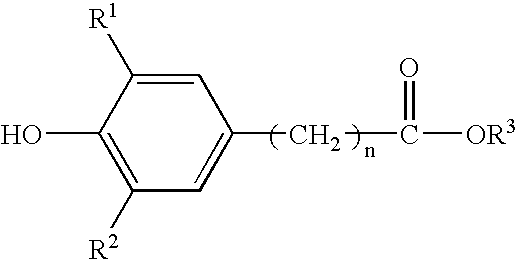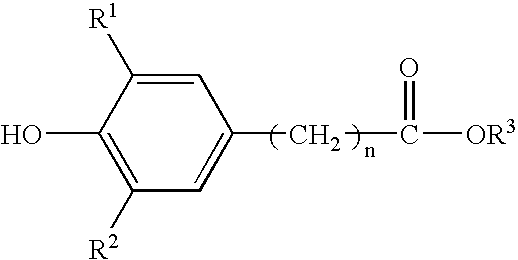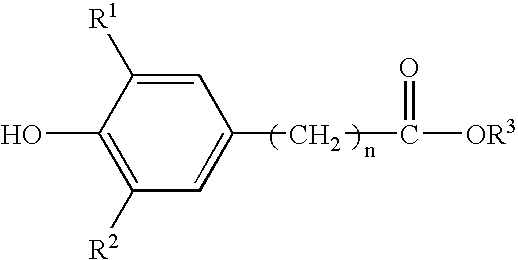Method for the preparation of a hydroxyalkyl hindered phenolic antioxidant
a technology of hydroxyalkyl hindered phenolic antioxidant and phenolic antioxidant, which is applied in the separation/purification of carboxylic acid esters, nuclear elements, group 3/13 element organic compounds, etc., can solve the problems of high production cost, high production cost, and high production cost, and achieve the effect of improving the solubility of the product and substantial process cost savings
- Summary
- Abstract
- Description
- Claims
- Application Information
AI Technical Summary
Benefits of technology
Problems solved by technology
Method used
Image
Examples
example 1
Comparative Example
[0064] This example illustrates the preparation of alkylhydroxy(3,5-di-t-butyl{4-hydroxyphenyl}propionate for use in the product of this invention and the removal of the catalyst by bicarbonate neutralization and water extraction of neutralization products. (Reference Example 1 in U.S. Pat. No. 5,698,499.) This is the standard preparation procedure of the prior art. Here, sodium bicarbonate is used to neutralize the acid and the by-products are extracted by water washes.
[0065] A five-liter, four-neck, round-bottom flask was equipped with an overhead stirrer, a subsurface nitrogen sparge tube, a thermocouple probe, and a Graham condenser. The Graham condenser was fitted with a simple distillation head and a condenser. The vessel was charged with 1,880 grams of methyl3-(3,5-di-t-butyl-4-hydroxyphenyl)propionate; 3,090 milliliters of 1,3-butanediol; and 12.8 grams of p-toluene sulfonic acid monohydrate. The mole ratio of 1,3-butane diol to phenolic ester reactant w...
example 2
[0068] In this Example, the overbased detergent / filtration procedure to neutralize and remove the catalyst and by-products is illustrated. The preparation of alkylhydroxy(3,5-di-t-butyl{4-hydroxyphenyl}propionate for use in the product of this invention and the removal of the catalyst by overbased detergent neutralization and filtration of neutralization salts is illustrated.
[0069] Methyl 3-(3,5-di-t-butyl-4-hydroxyphenyl)propionate (2.66 mol), 1,3-butane diol (5.32 mol), and p-toluene sulfonic acid (0.031 mol) were combined in a 2-liter reaction flask equipped with an overhead stirrer, thermocouple, nitrogen inlet and a distillation condenser. The reaction was run at 145° C. for 6 hours. Upon completion of the reaction, a sample was taken for gas chromatography analysis and then the catalyst was neutralized with HITEC 611, an overbased calcium sulfonate detergent with a TBN (total base number) of 300. The resulting product was opaque due to the calcium salt by-product. Vacuum dist...
example 3
[0072] This example illustrates the preparation of alkylhydroxy(3,5-di-t-butyl{4-hydroxyphenyl}propionate for use in the product of this invention. No attempt was made to neutralize or remove the catalyst from this product.
[0073] Methyl 3-(3,5-di-t-butyl-4-hydroxyphenyl)propionate (0.266 mol), 1,3-butane diol (0.532 mol) and p-toluene sulfonic acid (00.031 mol) were combined in a 250 mL reaction flask equipped with an overhead stirrer, thermocouple, nitrogen inlet, and a distillation condenser. The reaction was run at 145° C. for 8 hours. The excess diol was removed at 120° C. and 29 inches of mercury vacuum for 8 hours. The final product was a straw-colored medium viscosity liquid.
[0074] This example shows the effect of no neutralization on the catalyst level in the final product. This was the only sample with detectable levels of catalyst. The fact that there is not much present is due to its volatilizing off during the exaggerated (8 hour) vacuum strip. The strip step was exagg...
PUM
| Property | Measurement | Unit |
|---|---|---|
| temperatures | aaaaa | aaaaa |
| temperatures | aaaaa | aaaaa |
| reaction time | aaaaa | aaaaa |
Abstract
Description
Claims
Application Information
 Login to View More
Login to View More - R&D
- Intellectual Property
- Life Sciences
- Materials
- Tech Scout
- Unparalleled Data Quality
- Higher Quality Content
- 60% Fewer Hallucinations
Browse by: Latest US Patents, China's latest patents, Technical Efficacy Thesaurus, Application Domain, Technology Topic, Popular Technical Reports.
© 2025 PatSnap. All rights reserved.Legal|Privacy policy|Modern Slavery Act Transparency Statement|Sitemap|About US| Contact US: help@patsnap.com



